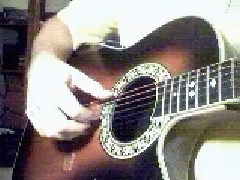Scroll through the lesson and click on notation/video/audio links to load the interactive players.
Please subscribe to get full access to all lessons for only $7.95/month PLUS 1 week free trial.

Riff Interactive lessons are
LESS expensive and
MORE interactive than alternatives!
More Info
|
|
| Lesson Subject:
Holiday Guitar |
| What you learn:
What Child Is This |
| Teacher:
Storm Stenvold |
Lesson Sample
Storm:
Welcome to the 'Holiday Guitar' series. In this series I will arrange some
familiar holiday songs into various styles like folk, country, jazz, and
classical. Some of the arrangements are simple, while others are more complex.
This lesson example is 'What Child is
This' which is a traditional Christmas tune that I've arranged into a folk
accompaniment
style. The focus for this lesson is on fingestyle accompaniment patterns. Later I will show an easy example of using 'chord
melodies' that allow you to play a solo rendition of the tune with harmony and melody
simultaneously.
Storm: The song starts with four
familiar chords Em, D, B7 & G.
Song
Chords

Storm: The picking patterns I've presented
can add life and variety to simple progressions that often make up the
harmony of holiday tunes. Here is the melody of the tune in two
parts.
Storm: And part B.
Storm:
It's always good to know the melody on your instrument, even if you are singing
or accompanying other instruments. Here are two accompaniment patterns that
serve as a basis for our right hand technique.
Fingerstyle Arpeggio
Storm: The
segment you just played is actually a broken chord or 'arpeggio' pattern. It fits nicely
over the E minor chord and 3/4 time signature used in this song. It is important
to setup your right hand fingers using the thumb on the bass strings (E, A, D)
and the index, middle, and ring fingers devoted to the higher single strings (E,
B, G). Here is a
loop of the first pattern.
Fingerstyle Arpeggio Pattern Loop
Right Hand
Technique

Storm: Fingerstyle picking can have an endless
amount of individual
patterns. I would suggest using this combination for this lesson: thumb + index,
middle & ring finger-per-string. This will help you keep the pattern consistent and
repeatable. The fingering of the right
hand allows you to play more than one note at a time or strum several
strings at the same time as well.
Fingerstyle Chord Techniques
Storm: You can play
some of the patterns with a pick as well.
glpaulguy: Teach, what is the best
way to improve fingerstyle? Practice with a
metronome?
Storm: A metronome will help
with almost every aspect of your technique. Like most things, just keep
practicing. Make sure you lose your pick for a week. Here's the next section.
Rhythm Guitar 1
Storm: This 8 bar pattern uses two
right hand picking techniques. Notice that the bass note moves in bars 5-8 while
playing the
same chord. A good rule of 'thumb' is to play the
root note and then move to the 4th string. If the root note is on the 4th string
you then move to the 5th string. This technique is called an alternating bass
pattern.
Rhythm Guitar 2
Storm: Here's a more
complex eighth note arpeggio pattern. The idea here is to build the intensity of
the song as you play through the verses. You start with simpler picking pattern
and build to the more complex patterns later in the song. You can mix and match
picking patterns as you gain more experience, we will explore more techniques
later in this lesson.
Rhythm Guitar 3
Rhythm
Guitar 4
Rhythm Guitar 4 Left hand
Storm:
Here I introduce the G major chord and then D
major. You might notice I use a 'pinch' technique where the thumb and finger (or fingers) play at the same
time. In bars 3-4 the D chord slides
from one D form to another.
Rhythm Guitar 5
Storm: Here's another
example of using two
different chord forms, but this time you use E minor. You also 'rake' or
'drag' the thumb while playing consecutive notes on the B7.
Storm: Here's an example of a four finger
'pinch,' this technique is very common classical guitar.
Rhythm Guitar 7
Storm: Notice the
harmonics played in the last bar. You can play harmonics by lightly touching the strings above the 12th fret
then striking the notes.
Storm:
In the next three examples I've arranged the melody using chords underneath each
bar. This technique will prep you for the jazz chord melodies I will show you
later in this lesson series.
Storm: We now move to the second barre at the 8th
fret, this technique is called a 'hinge barre', where your finger plays using
the fingertip while it lays down
to sound a note.
Storm:
In this segment we are playing simple triads below the melody notes on the 2nd
string. In the next four bars you use the
same technique as example 9 as well.
Storm: OK start practicing and make this a
holiday season to remember. You might also check out my arrangement of this
tune, also known as 'Greensleeves', in my Classical Guitar series as well. Remember, playing for the family reminds
them that guitars make great gifts!
|
<< load notation from left
|
|
<< load audio from left
|
<< load audio from left
|